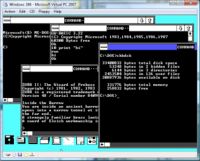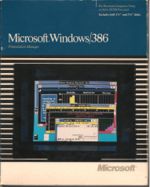Difference between revisions of "Windows 2.0"
(→Windows/386) |
|||
| Line 10: | Line 10: | ||
[[Image:Windows 386 2.1 back.jpg|150px]] | [[Image:Windows 386 2.1 back.jpg|150px]] | ||
| − | Windows/386 was Microsoft's first product to allow people to directly use the V86 mode of the 80386 cpu. With enough expanded memory you could run several virtual MS-DOS machines. | + | Windows/386 was Microsoft's first product to allow people to directly use the V86 mode of the 80386 cpu. With enough expanded memory you could run several virtual MS-DOS machines. What was 'cool' is that each VDM was copied from the primary memory map, so that way each VM had the same operating features, and each had the same ammount of free memory. The selling point at the time, was that each VDM could run it's own programs in it's own memory space. From the sample picture, a VM is running [[GW-Basic]], another is running [[Zork II]], and another is running chkdsk. Each one started up with the same ammount of free memory. Windows/386 also facilitated basic clipboard operations between VM's so you could copy data between MS-DOS applications, and of course Windows applications. |
| + | |||
| + | Windows/386 shipped with a 'working model' of Excel, that was limited to 16 colums and 64 rows. | ||
{{stub}} {{nav Microsoft Windows}} | {{stub}} {{nav Microsoft Windows}} | ||
[[Category:Operating Enviroments]] | [[Category:Operating Enviroments]] | ||
Revision as of 05:13, 12 September 2009
Windows 2.0 was the second release of the Microsoft Windows enviroment for MS-DOS. It was not a commercial sucess, however it furthered the development of the kernel so that it could use XMS memory, and it later introduced a 286 specific version that could do some limited multitasking with MS-DOS, and a 386 specific version that could spawn multiple VDM's.
It was superceded by Windows 3.0.
Windows/286
This version had some specific code to the 80286 cpu allowing limited MS-DOS multitasking. However since each instance of MS-DOS consumed the same limited 640kb memory pool, it was largely ineffective.
Windows/386
Windows/386 was Microsoft's first product to allow people to directly use the V86 mode of the 80386 cpu. With enough expanded memory you could run several virtual MS-DOS machines. What was 'cool' is that each VDM was copied from the primary memory map, so that way each VM had the same operating features, and each had the same ammount of free memory. The selling point at the time, was that each VDM could run it's own programs in it's own memory space. From the sample picture, a VM is running GW-Basic, another is running Zork II, and another is running chkdsk. Each one started up with the same ammount of free memory. Windows/386 also facilitated basic clipboard operations between VM's so you could copy data between MS-DOS applications, and of course Windows applications.
Windows/386 shipped with a 'working model' of Excel, that was limited to 16 colums and 64 rows.
| v • d • e Microsoft Windows Versions, Vendors and Related |
|---|
| 16 bit - Windows 1.0 • Windows 2.0 • Windows 3.0 • Windows 3.1 • Windows 3.2
Hybrid 32/16 bit - win32s • Windows 95 • Windows 98 • Windows ME 32 bit - Windows NT 3.1 • Windows NT 3.5 • Windows NT 3.51• Windows NT 4.0 |


